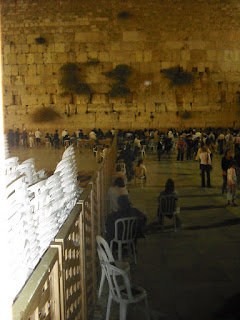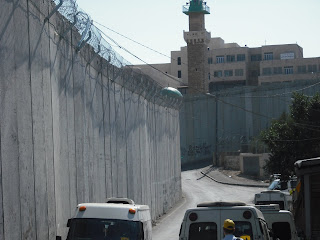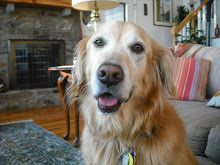
A Pilgrimage Prayer
O Lord God,
from whom we come,
in whom we are enfolded,
to whom we shall return,
bless us in our pilgrimage through life;
with the power of the Holy One protecting,
with the love of Jesus indwelling,
and the light of the Spirit guiding,
until we come to our ending,
in life and love eternal.
Amen.
(Prayer taken from "600 Blessings and Prayers from around the world", compiled by Jeffery Duncan - the above prayer is found on page 355 is a prayer from Peter Nott in England.)
On Friday I leave the glory of the mountains for Raleigh. I will spend the night near the airport and then fly on Saturday morning to Washington, DC. Our delegation (21 persons) will meet at Interfaith Peace Builders for an orientation session in the afternoon. We will continue on Sunday morning and then in the afternoon we will fly to Tel Aviv from Washington. Our first day in Israel will be spent getting settled in in Jerusalem. From there we will travel to and stay in a variety of places on the West Bank and in and near Jerusalem. I have found myself over the past few days both excited and somewhat anxious regarding these adventures. I am excited about what I will learn and I am hopeful that I am "quiet" enough inside to really pay attention.
(I am trying to be very quiet as I sit here right now because there are 2 beautiful young does feasting on the bird food just outside my window. They are carefully avoiding stepping on the feisty little squirrel gathering food at the same feeder! So much for feeding the birds!)

I have almost finished reading David K. Shipler's book "Arab and Jew: Wounded Spirits in a Promised Land". He wrote the first edition in 1986 in what he calls "a more innocent time." Ironically this is about the same time I first visited Israel on a pilgrimage to the holy sites. His second edition was published in 2002 and it contains the text of the first edition as it was published in 1986, and updated material at the end of most chapters. Shipler lived in Israel writing for The New York Times. The book is quite a "tome" of some 500 + pages, and it is one of the most helpful books I have read. Shipler presents an Arab perspective and an Israeli view using facts, the accounts of history, and stories that are illuminating. He is a journalist, who is neither Jew nor Arab and he seeks to present an account of both perspectives. All of the persons in his book are real and the stories are poignant and disturbing. I had to put the book down periodically to rest my mind. At one point I wrote these words in my journal:
My ears are tired,
my eyes are wearied.
Abraham and Sarah
childless, should have
adopted.
Shipler quotes the philosopher, David Hartman, when he talks about the "land had become an idol." In a longer quote from Rabbi Hartman, he focuses on "yearning for something that is beyond strength." In Hartman's words: " What happens when reality imposes itself on a dream? I have to say that the purpose of the Jewish return is to restore the dignity of particularism. The question is how do I treat the Arab, how do I treat Christians, how do I treat the Jews who are not religious? He who thinks he has the truth can be intolerant. We have not developed the pluralistic type. Jews here have not understood what I think to be the larger significance of the Jewish return: a pluralistic consciousness which feels that David Shipler and Hartman could really embrace each other as friends, knowing each other in their differences, and listen to each other... Unless fundamentalism gets healed, unless pluralism become a spiritual value, I don't see any future in the Middle East." (page 139 of Arab and Jew)
Throughout the book, Shipler notes how poverty provides a fertile ground for militance and unyielding demands on both sides. The echo of Rabbi Hartman's words above, "the land had become an idol", rings with truth in the entirety of the book. Shipler is more than helpful in the later chapters of the book as he presents information about the cultural aspects of both the Muslim and the Jew in Israel. Since I will be staying in Israeli and /or Muslim homes for 3 nights of the trip, I have tried to pay attention to his practical advice for being a guest.

I'll end this post with a picture of some "grown up" Christmas trees. I neglected to say in the post with the "baby Christmas trees" that the tree grown here is the Fraser Fir. It is a beautiful tree, grown extensively here in the mountains of NC. It is dense (good for hanging ornaments) and has dark green needles with a silver underside. It has a light, soft wood which makes it great for shipping to places that don't grow Christmas trees. Now, I've done my bit of advertising for the NC Christmas tree!





 St. Paul's Within the Walls
St. Paul's Within the Walls This is a wonderful icon that was on the altar at St. Paul's Within the Walls yesterday morning - it is Sts. Peter and Paul. Tomorrow after doing some work in the internet café we are going to the Coliseum, hoping not to get eaten by any lions!
This is a wonderful icon that was on the altar at St. Paul's Within the Walls yesterday morning - it is Sts. Peter and Paul. Tomorrow after doing some work in the internet café we are going to the Coliseum, hoping not to get eaten by any lions!











 I've been watching this Japanese Maple for days now. In the afternoon it glows! It has become my "burning bush." Sometimes I catch a glimpse of it out of the corner of my eye and think that the woods have caught on fire. It is such a stark contrast to the many evergreens around. And if the bush were on fire but not consumed what would I do? I suspect I would be on my knees on the back deck 24/7.
I've been watching this Japanese Maple for days now. In the afternoon it glows! It has become my "burning bush." Sometimes I catch a glimpse of it out of the corner of my eye and think that the woods have caught on fire. It is such a stark contrast to the many evergreens around. And if the bush were on fire but not consumed what would I do? I suspect I would be on my knees on the back deck 24/7.

 I'll end this post with a picture of some "grown up" Christmas trees. I neglected to say in the post with the "baby Christmas trees" that the tree grown here is the Fraser Fir. It is a beautiful tree, grown extensively here in the mountains of NC. It is dense (good for hanging ornaments) and has dark green needles with a silver underside. It has a light, soft wood which makes it great for shipping to places that don't grow Christmas trees. Now, I've done my bit of advertising for the NC Christmas tree!
I'll end this post with a picture of some "grown up" Christmas trees. I neglected to say in the post with the "baby Christmas trees" that the tree grown here is the Fraser Fir. It is a beautiful tree, grown extensively here in the mountains of NC. It is dense (good for hanging ornaments) and has dark green needles with a silver underside. It has a light, soft wood which makes it great for shipping to places that don't grow Christmas trees. Now, I've done my bit of advertising for the NC Christmas tree!

